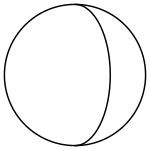Gibbous-Crescent-half-ellipse-in-circle-outlined.png
Summary
| Description Gibbous-Crescent-half-ellipse-in-circle-outlined.png | A circle divided into a gibbous shape (left) and an astronomical crescent shape (right) by a half-ellipse, where the major axis of the ellipse coincides with a diameter of the circle. According to geometry, an illuminated hemisphere of a sphere will appear to take on such gibbous or crescent shapes when viewed from an angle. In this case, the length of the major axis of the ellipse is twice the length of the minor axis (i.e. the eccentricity is half the square root of 3), so that the larger gibbous area shows the theoretical shape of the visible lit area of the moon (for example) when the separation between the viewing angle and the angle of illumination (i.e. between Earth and Sun) is 60 degrees, while the smaller crescent area shows the theoretical shape of the visible lit area of a sphere when the separation between the viewing angle and the angle of illumination is 120 degrees. See also Image:Gibbous-Crescent-half-ellipse-in-circle.png | |||||
| Date | ||||||
| Source |
Generated from a version of the following PostScript source code: %! 3 setlinewidth 300 156 144 0 360 arc gsave 1 setgray fill grestore stroke 300 12 moveto 39.765 0 72 64.471 72 144 rcurveto 0 79.529 -32.235 144 -72 144 rcurveto stroke showpage %%EOF |
|||||
| Author | AnonMoos | |||||
| Other versions |
|
Licensing
| Public domain Public domain false false |
|
|
I, the copyright holder of this work, release this work into the
public domain
. This applies worldwide.
In some countries this may not be legally possible; if so: I grant anyone the right to use this work for any purpose , without any conditions, unless such conditions are required by law. |
Captions
Add a one-line explanation of what this file represents



